Health
When West Nile Virus Turns Deadly



By Zoya Teirstein, Grist
“This story was originally published by Grist. Sign up for Grist’s weekly newsletter here.”
James Parravani came down with flu-like symptoms the day before his daughter’s wedding reception. He had a fever, a headache, and chills. It was Labor Day weekend 2021, and his family thought he might have COVID-19. But a test at an emergency room near his home in Westchester, New York, came back negative.
The ER doctors quickly transferred Parravani to Yale New Haven Hospital in Connecticut, where he had received a kidney transplant a year prior. The specialists there suspected he might have a kidney or blood infection related to his operation. They gave him a round of antibiotics, but he just kept getting worse.
Parravani, known to friends and family as Jim, took a long, winding road to his daughter’s wedding weekend. He dropped out of high school in Schenectady, New York, before his senior year to focus on other priorities. “Rocktoberfest” — a music festival he and his friends threw in a rented-out motel — occupies a near-mythical place in modern Schenectady history. Parravani eventually earned his GED and attended Syracuse University’s College of Law, where he rose to second in his class.
After marrying his middle school sweetheart in 1986, Parravani graduated from law school, moved to Westchester, and began building a career and a family. But in the ’90s, he learned he had a genetic condition called polycystic kidney disease — an illness that causes cysts to grow on the kidneys and often results in organ failure. After several years of treating his cysts, Parravani’s doctors initiated the laborious process of getting him a transplant. In 2020, about a year before his daughter’s wedding weekend, he finally got one.
Now, his doctors thought this transplanted kidney might be making him sick, though they still didn’t know how. The morning of her reception, Jenny Parravani Davis called her dad at the hospital. She asked him if he wanted her to postpone the festivities. “No, no,” he told her. “Keep going.”
From left: Jim Parravani with his daughter, Jenny, as a toddler. Father and daughter on Jenny’s prom night. Courtesy of Jenny Parravani Davis
That was the last lucid conversation Davis ever had with her father. The next day, she got a call from her mother. Parravani was deteriorating — fast.
“He got on the phone and he was really disoriented, he couldn’t form words,” Davis said. “I remember saying ‘Hi, I love you,’ and he just said, ‘Don’t cry,’ and everything after that was incoherent.” Parravani was intubated that same day.
The doctors ran dozens of tests and put Parravani on multiple courses of strong antibiotics to treat the infection. It was only when they conducted a spinal tap — about a week after Parravani’s initial admission — that they discovered the true culprit: West Nile virus was present in his cerebrospinal fluid. The disease had spread to his brain and was making it swell. (Yale New Haven Hospital declined to comment on Parravani’s care.)
For seven months, as Parravani slipped in and out of comas, the doctors tried to beat back the virus with intravenous fluids, pain medication, and oxygen. At one point, it looked like Parravani might pull through. He was nodding and trying to communicate with his family around his breathing tube. The doctors reduced the oxygen flowing through his ventilator, and he breathed on his own. But in March 2022, Parravani began to decline again. On April 13, Parravani died in hospice care. He was 59 years old.
West Nile has been the most common mosquito-borne illness in North America for more than two decades. States in the Great Plains and western U.S. typically report the highest number of cases, though outbreaks have happened in nearly every state in the continental U.S. The disease has killed more than 2,300 people since it first arrived here, and the number of people affected by the virus every year is poised to rise.
As climate change extends warm seasons and spurs heavier rainstorms, the scope and prevalence of West Nile virus is shifting, too. Warmer, wetter conditions allow mosquitoes to develop more quickly, stay active beyond the traditional confines of summer, and breed more times in a given year. Birds, which host West Nile virus and pass it onto mosquitoes that bite them, are adjusting their migration patterns in response to the melding seasons.
The confluence of these two trends could have serious consequences for human beings. West Nile virus, a recent study said, “underlines once again that the health of animals, humans, and the environment is deeply intertwined.” In the past few years, Colorado and Arizona recorded outbreaks of the virus that killed scores of people in each state. Parts of California and Wyoming also reported unusually high cases of the disease. Meanwhile, Nevada, Illinois, and New York registered above-average or record-breaking numbers of West Nile-infected mosquitoes and mosquito activity.
“Overall, the evidence points to higher temperatures resulting in more bird-mosquito transmission and more what we call spillover infections to people,” said Scott Weaver, chair of the department of microbiology and immunology at the University of Texas Medical Branch.
West Nile virus typically leaves young, healthy individuals unscathed. Only 1 in 5 people who contract it develop symptoms, which can include fever, headache, joint pain, diarrhea, and other signs of illness that often resemble the flu.
There is no cure for West Nile virus; the immune system must fight it off on its own. That’s why elderly people and those with preexisting conditions, such as cancer, diabetes, and kidney disease, are at much higher risk of developing the severe form of the disease. So are organ transplant recipients, who take immunosuppressants for their entire lives to ensure the body does not reject the organ.
About 1 in 150 people who get West Nile develop the worst form of the illness, in which the virus attacks the central nervous system. For 10 percent of these patients — including Parravani — encephalitis or meningitis, swelling of the tissues around the brain and spinal cord respectively, leads to death.
Because only a sliver of infected people get seriously sick, the impact of West Nile virus on the public hinges on the number of people who contract the disease. Some years, the number of infections detected in the U.S. approaches 10,000. Other years, there are fewer than 1,000 reported cases. The number depends in large part on environmental conditions — how much rain fell, how warm or cold the spring or fall was — in addition to bird migration patterns and human behavior.
“It’s a rare event that any given mosquito bites a bird and then survives long enough to bite a human” and transmit West Nile virus, said Shannon LaDeau, a disease ecologist at the Cary Institute of Ecosystem Studies. But as with COVID-19, the size of the denominator is crucial. “When you have millions of mosquitoes, that rare event happens more frequently.” LaDeau said.
Parravani’s illness wasn’t the first case of West Nile to stump medical professionals in the U.S. In August 1999, people in the New York City metropolitan area started becoming severely ill with encephalitis. The patients had previously been healthy and reported being outside in the days leading up to their illness. The New York City Department of Public Health suspected a disease spread by mosquitoes was behind the outbreak and immediately launched an investigation.
In the months before the outbreak, researchers in New York had detected an unfamiliar type of single-stranded RNA virus in some of North America’s wild birds. Birds of prey and members of the crow family, in particular, were dying in unusually high numbers. Four weeks after the people in New York got sick, the chief pathologist at the Bronx Zoo connected the dots and sounded the alarm. The birds were infected with West Nile virus, named after the district in northern Uganda where the disease was first isolated in a human more than half a century earlier. And West Nile, public health authorities eventually confirmed, was what was making New Yorkers sick.
By the end of the summer, 59 people had been hospitalized with West Nile virus. Seven died.
West Nile had been known for decades to cause fever, vomiting, headache, and rashes. Epidemics in the Middle East in the early 1950s helped researchers confirm that the Culex genus of mosquito — dawn and dusk biters that prefer to feed on birds — were the primary vector, or carrier, of the disease. Outbreaks of varying severity cropped up all over the world — in France, India, Israel, Italy, Morocco, Romania, Russia, South Africa, Spain, and Tunisia. But it wasn’t until 1999 that researchers understood that migratory birds could spread the virus from one hemisphere to another.
Once public health officials learned what was behind the encephalitis outbreak in New York, they sprayed pesticide and larvicide around the city to kill mosquitoes. But the disease couldn’t be eradicated. Within three years, birds had carried it from coast to coast and throughout much of Canada.
The public health response to West Nile virus in the U.S. since the turn of the century has been punctuated by successes and setbacks. Every few years, when environmental conditions allow Culex populations to boom, cases careen out of control and hundreds of people die. States and cities often belatedly deploy weapons from a limited arsenal — pesticide-spraying and public awareness campaigns — to keep the disease in check. After a boom year, the next one often brings a different cocktail of environmental conditions, and the disease has a much smaller impact on public health.
“There are many things that go into what causes the circulation of West Nile,” said J. Erin Staples, a medical epidemiologist at the Centers for Disease Control and Prevention, or CDC. “And that makes it very difficult for us to predict.”
The unpredictability of the virus is part of what explains the lackluster response by states and the federal government to the threat of West Nile. No vaccine or cure exists, and funding for research on the disease is low, despite the fact that the virus has been claiming lives in North America for a quarter of a century. “Although West Nile virus continues to cause significant morbidity and mortality at great cost, funding and research have declined in recent years,” a 2021 study said. The National Institutes of Health directed $67 million to West Nile research between 2000 and 2019 — less than a tenth of the $900 million it dedicated to research on Zika, a mosquito-borne illness that never gained a foothold in the U.S., in the same period.
Experts warn that climate change is creating more opportunities for West Nile to spread.
Culex mosquitoes thrive in temperate, wet weather. Like other mosquitoes, they lay their eggs in standing pools of water. The eggs can’t survive below about 45 degrees Fahrenheit, but as temperatures get warmer from there, the time between hatching and reproducing gets shorter. The mosquitoes’ ideal temperature for survival ranges from 68 to 82 degrees Fahrenheit, depending on the precise species, but one Culex species can spread West Nile when it’s anywhere between 57 and 94 degrees F outside.
As temperatures rise and make fall, winter, and spring milder, Culex mosquitoes will have more chances to reproduce and spread West Nile in places that didn’t used to see so many mosquitoes. Meanwhile, because a warmer atmosphere holds more water, extreme rain events are getting more common — and that means more standing water for mosquitoes to breed in.
In New York, where winters are warming three times faster than summers, mosquitoes are now active deep into the month of November. A few decades ago, an adult mosquito flying around past the middle of October would have been highly unusual. “We are starting to see and will continue to see shifts in the range” of West Nile virus, said Laura Harrington, an entomology professor at Cornell University, “and shifts in some of the avian hosts that are most important.”
Climate change also pushes birds into new areas, because of weather changes and adjustments in where and when different types of plants and trees grow and bloom. “There are changes to the habitat where birds migrate to breed every year in the Northern Hemisphere,” said Weaver, the University of Texas microbiologist. “And just the temperature itself may have an impact on migration.” As birds enter new habitats, they have the potential to bring West Nile with them.
There’s already evidence that climate change is fueling West Nile outbreaks. In 2021, Maricopa County, Arizona, got an unusual amount of rain — 6.6 inches between June and September, compared to the 2.2 inches it usually gets during that period. That summer, Maricopa County experienced a historic surge of West Nile virus — the worst outbreak in a U.S. county since the disease arrived 25 years ago. Roughly 1,500 people were diagnosed, 1,014 were hospitalized, and 101 people died. The previous year, the number of recorded cases in the region was in the single digits.
A determining factor in the outbreak, Staples said, was the unusual amount of rain. It led to “an unprecedented increase in the mosquitoes and the ability of that virus to then spread to people.” Arizona is projected to get more bouts of extreme rainfall as the planet warms.
To prevent West Nile outbreaks, public health officials must monitor mosquitoes and birds for the virus. But the behavior of mosquitoes makes surveillance complicated — trickier even than tracking other vectors of disease, such as ticks. Unlike ticks, which stay more or less put, mosquitoes can travel a mile or two in any direction. That means public health agencies must launch an expensive and time-consuming hunt for the bugs, using field tests, maps, and guesswork to figure out where mosquitoes are hiding. Birds are mobile, too, and that further complicates efforts to track, map, and control the disease.
Even accounting for these challenges, epidemiologists say too few states are deploying sufficient effort and resources to make sure that they are able to predict and respond to outbreaks of West Nile virus. “We still are using the same vector control and the messaging to use your insect repellant that we were using 25 years ago,” Staples said.
Some states are doing a better job than others. Massachusetts and New York, among the most aggressive states in the nation when it comes to tracking West Nile virus, test mosquito breeding sites and birds regularly and, when positives come back, use that information to inform the public. After Parravani’s spinal tap revealed that he had West Nile, the Westchester County Health Department went to his house and conducted a sweep of the property. County public health officials drained pools of standing water in the backyard where the mosquitoes had likely bred, and they encouraged nearby residents to do the same on their own properties.
“In some places there’s a very clear link that guides when you test and what you test for,” LaDeau said. But “mosquito surveillance is not the norm across all regions, and it’s not standardized among even regions within a state.”
As climate change loads the dice in favor of mosquitoes, West Nile is not the only infectious illness in flux. The number of cases of vector-borne disease in the U.S. have more than doubled since 2001. Some of that increase can be attributed to better disease awareness among physicians and the public, and an uptick in testing as a result. But there are also examples of diseases bursting out of the regions where they have historically been found, which may be an indication that changes in the environment are coaxing carriers of disease into new places.
In 2023, the U.S. saw the first-ever cases of locally transmitted dengue fever in Southern California and unusual cases of locally acquired malaria in Texas, Florida, and Maryland. When a mosquito imparts West Nile virus to a human, the transmission of the virus stops there. An infectious human cannot infect a mosquito with the virus. That’s not the case for dengue and malaria, which makes the spread of those diseases potentially far more dangerous.
Many studies show that infectious diseases will take a larger toll on public health across North America as we make our way deeper into the 21st century. “More Americans are at risk than ever before,” Christopher Braden, the acting director of the CDC’s Center for Emerging and Infectious Zoonotic Diseases, warned in 2022.
If West Nile virus, the nation’s most common mosquito-borne illness, is a test for how the U.S. will weather the coming influx of vector-borne disease, then the country is in bad shape. “We don’t have very good tools to control it and prevent human illness,” Harrington said.
For now, however, those who have been personally impacted by mosquito-borne illnesses are arming themselves with DEET and ringing the alarm. Until recently, Jenny Parravani Davis worked as a communications manager for the Wilderness Society, a land conservation organization that advocates for better protection of the nation’s remaining wild places. The climate change reports that the Wilderness Society puts out generally include top-line findings about the ways in which climate change will erode human health as temperatures rise. But her father’s death, Davis said, drove home just how interconnected these issues really are.
“I started to connect the dots and see the bigger picture,” she said. Her backyard in Virginia collects a lot of water, especially in recent years, as back-to-back record-setting rain events have flooded the state. “I don’t think anyone would blame me, but I’ve developed this neurosis where anytime I scratch a mosquito bite I’m like, ‘Could this be the thing that kills me today?’” she said. “I’ve seen what happens when we don’t pay attention to these things.”
Correction: This story originally misstated Jenny Parravani Davis’ first name.
This article originally appeared in Grist at https://grist.org/health/west-nile-virus-mosquito-climate-change/.
Grist is a nonprofit, independent media organization dedicated to telling stories of climate solutions and a just future. Learn more at Grist.org
—
This story was originally published by Grist.
***
Join The Good Men Project as a Premium Member today.
All Premium Members get to view The Good Men Project with NO ADS.
A $50 annual membership gives you an all access pass. You can be a part of every call, group, class and community.
A $25 annual membership gives you access to one class, one Social Interest group and our online communities.
A $12 annual membership gives you access to our Friday calls with the publisher, our online community.
Register New Account
Need more info? A complete list of benefits is here.
—
Photo credit: iStock.com
Health
Brooks Ghost Max Running Shoes Are Nearly $50 Off Right Now

Men’s Journal aims to feature only the best products and services. If you buy something via one of our links, we may earn a commission.
Dick’s Sporting Goods is in the midst of a major sale on running shoes from brands like Hoka, On, and Nike, with Brooks accounting for some of the retailer’s most appealing discounts. Styles like the Glycerin StealthFit and the Adrenaline GTS are on sale, but the one turning heads right now is the high-stack and ultra-cushioned Ghost Max—and it’s selling fast.
Right now,
Brooks Ghost Max Running Shoes in Black/Ebony, $102 (was $150) at Dick’s Sporting Goods
The Ghost Max takes all the best features of the traditional Ghost running shoe, like great breathability and ample under-foot support, and adds a super high-stack cushion that amplifies protection and shock absorption from surface textures. This is a huge upgrade for those with sensitive feet, as it decreases the pressure exerted on the foot, and the larger cushion also provides a wider base, which helps with stability. And, though this sneaker has a more level 6 mm heel-to-toe differential (half that of the normal Ghost), it uses a rocker bottom to help achieve a smooth, comfortable stride when walking.
The maximum cushion is an immediate standout for anyone who steps into these Brooks running shoes, especially those who have to stand a lot. “I’m not a runner, but stand on concrete all day,” a shopper began. “They are, by far, the most cushioned and comfortable shoes I’ve ever worn. I’ve tried Hoka, Asics, and Oofos, but the Ghost Max is my favorite. If you need cushion in your step, look no further.” Another shopper agreed, simply saying they were “super comfortable shoes” with “lots of support.”
Brooks Ghost Max Running Shoes in Cream, $102 (was $150) at Dick’s Sporting Goods
In some cases, shoppers are even switching from their Ghosts—the brand’s most popular sneaker—in favor of this model. “I have been a Brooks Ghost user for many years,” a shopper said. “Love the Ghost Max. Superior cushioning is the key. Being a larger runner of over 30 years (6-foot-3, 240 pounds) the extra cushioning is very much appreciated. The shoes fit perfectly and the ride is smooth. My knees, ankles, and thighs thank you!”
Whether you’re looking for the perfect walking shoe or some extra protection from a daily runner, it’s well worth trying the
Prices are accurate and items in stock at time of publishing.
Health
Bridging Generational Divides in Medical Education: Gen Z Med Students’ POV



By Nichole Sanchez Diaz, Sanja Kostov, Erin Bearss, Milena Forte
What comes to mind when you think of “Gen Z” (1996-2010)?
Anecdotally, it seems preceding generations (Boomers, Gen X, Millennials) have seen us as “digitally savvy yet too sensitive.” And while we cannot generalize an entire cohort, there’s truth that this is generating friction in medical education.
Raised in the digital age, Gen Z faces higher rates of mental health issues than its predecessors. This cohort also has a stronger desire to uphold principles of equity, diversity and inclusion (EDI) that can sometimes challenge traditional medical teachings, thus creating novel tensions between medical trainees and their educators.
Medical training is notoriously challenging, with responsibility and stress levels increasing with each passing year. It compares to the stress of starting a new job every few months while being the least informed contestant in a never-ending Jeopardy episode. When you add in the sleep deprivation that comes from working around the clock, it’s not surprising that training can negatively impact the mental health of medical learners. A 2018 Canadian Medical Association survey revealed alarming rates of burnout and depression among resident physicians; more recent studies point to this being an even bigger issue since the pandemic. Given that circumstances have made Gen Z appear to be even more psychologically vulnerable than previous generations, what measures have been implemented to ensure their collective success and are these measures sufficient?
In recent years, institutions have rolled out wellness programs and mental health services. These are steps in the right direction, but are often inaccessible to trainees , especially during residency. The unwritten expectation of self-sufficiency discourages trainees from openly discussing their mental health needs with educators, fearing they may be perceived as fragile or, worse, incompetent.
Recent studies reflect what Gen Z residents value in wellness strategies: clear communication and community building, particularly with their educators. Despite their digital upbringing, they crave in-person teaching and opportunities to develop deeper connections with their mentors.
Educators can play a pivotal role in dismantling the stigma surrounding mental health during medical training. By sharing their personal experiences and coping mechanisms, and promoting wellness resources, they can normalize discussions around mental health and burnout; topics with which many trainees struggle but are afraid to vocalize. An honest dialogue between mentor and mentee is a powerful tool for building mutual trust and can increase the chances of identifying and addressing mental health challenges before they escalate.
As an ethnically and socially diverse cohort, Gen Zs recognizes EDI as more than a buzzword.
Gen Z medical learners can also take steps, such as understanding their program’s purpose and expectations, establishing clear expectations with their educators, and identifying existing resources in advance. If they encounter challenges, they should investigate and access formal supports offered by their programs (e.g., accommodations or extensions to training) to avoid sacrificing their well-being.
As an ethnically and socially diverse cohort, Gen Zs recognizes EDI as more than a buzzword; it is an expectation of their future workplace. Their openness to embrace new perspectives combined with unparalleled access to information online makes them more likely to challenge long-standing practices.
For example, a preceptor commenting on the risks of high BMI can provoke discomfort in a student who believes it perpetuates fat-phobic attitudes, influenced by social media discussions about patient discomfort with weighing at medical visits. The emphasis on political correctness has made some physicians cautious when teaching, fearing a backlash. To remedy this, educators can practice listening to and understanding student perspectives, especially those discordant with their own. Using this as a teaching opportunity, faculty members can discuss evidence supporting their clinical practice and share personal experiences while simultaneously addressing gaps in their knowledge and updating outdated terminology.
Learners should feel empowered to challenge established medical practices, but they need to be cautious about forming their beliefs based on virtual discourse that can spread misinformation, particularly when they have limited clinical experience. Clinical educators can often contextualize and tailor available evidence to specific patient situations based on their medical expertise and a host of varied patient experiences. Embracing opportunities for humility and shared learning enables a safe learning environment that encourages curiosity and ensures training is rooted in evidence-based practice. While these are difficult conversations, they are vital because dismissing learner concerns only leads to mistrust.
Adapting medical education for Gen Z learners isn’t about coddling – it’s about evolution. This is a call for educators to acknowledge generational differences and be willing to gradually shift the hustle culture of medical training to foster a more supportive learning environment through respectful dialogue.
Gen Z respects authority but will learn best under mentors who encourage transparent discussions around mental health and social accountability in medicine. For students to fully benefit from their education, they must also clearly understand the expectations of their roles. By embracing innovation while upholding core values in medical education, we can shape students into resilient professionals who can thrive in today’s demanding health-care landscape.
—
Previously Published on healthydebate.ca with Creative Commons License
***
You Might Also Like These From The Good Men Project
All Premium Members get to view The Good Men Project with NO ADS. A $50 annual membership gives you an all access pass. You can be a part of every call, group, class and community. A $25 annual membership gives you access to one class, one Social Interest group and our online communities. A $12 annual membership gives you access to our Friday calls with the publisher, our online community. Need more info? A complete list of benefits is here.
—
Photo credit: iStock
Health
15 Best Gay Sex Positions for Couples to Explore

When it comes to gay sex positions, pleasure isn’t one-size-fits-all. Men looking for fun and different sex positions should play around with unique missionary sex positions, 69 sex position variations, and even Amazon sex position to add excitement and novelty. Experimenting with lubes and sex toys for men (think prostate massagers, anal beads, and cock rings) will only enhance the best gay sex positions, so come to the bedroom with an open mind.
Like any sexual experience, gay sex is personal and there’s a lot of experimentation that can be done to understand your preferences and the preferences of your partner.
“Some men don’t understand what exactly turns them on,” says Finn Deerhart, AASECT-certified sexuality counselor, who works primarily with queer men. “They assume their turn-on is a causal result of the objects they desire or a set of conditions. However, when it comes to sexual arousal, and the deeply personal nature of that energy, it’s less about the specific objects and more about the implied sense of meaning a man derives from his sexual experiences.”
Below, Deerhart, alongside multiple sex experts, share a guide to the best gay sex positions for men that will offer inspiration to try something new, lean into what you like most, and connect with your mind-body connection to be a better lover.
1. Doggy Style
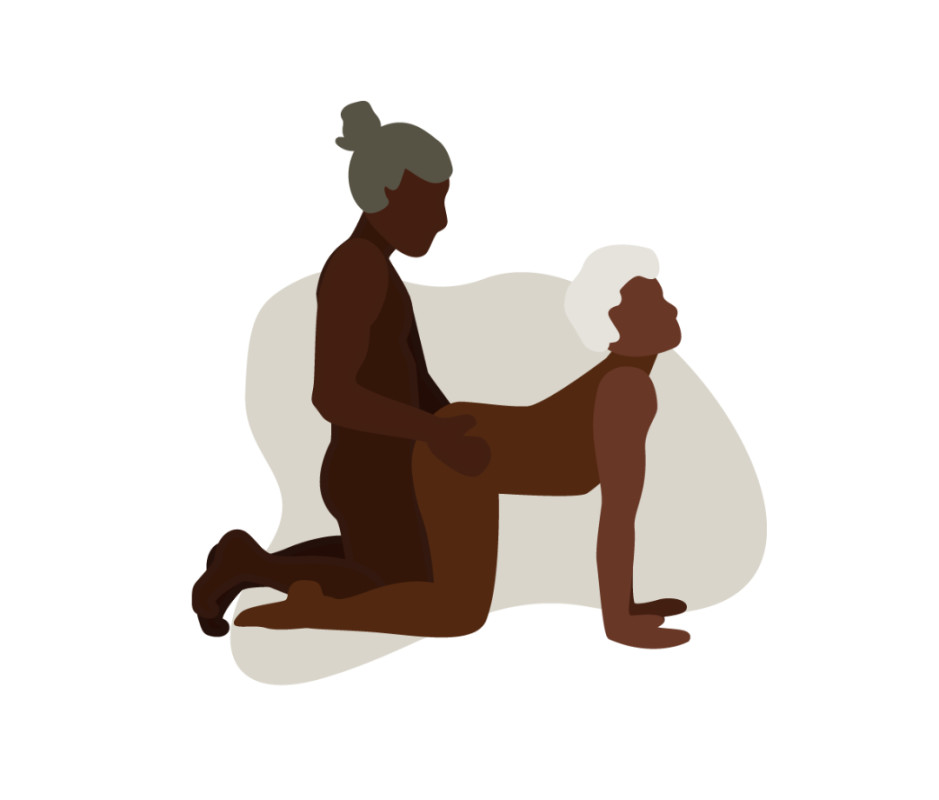
Katie Buckleitner
How to Do It
“This one is a staple for many gay men,” says Deerhart. The receiver kneels or stands facing away from the penetrator. With hips raised, the receiver takes the penetrator as deeply as they desire.
Why It Works
“The absence of eye contact is part of why men love doggy style,” says Deerhart. “They’re able to tap into their animal bodies while enjoying a degree of emotional opacity.” Removing direct eye contact can help lower inhibitions and encourage partners to be more present in the moment.
| Pros | Cons |
|---|---|
|
Deeper penetration |
Can be too deep for the receiver, depending on capacity and depth |
|
Freedom of movement for the one thrusting |
|
|
Receiving partner can masturbate, if desired |
|
|
Lack of eye contact lowers inhibitions |
Pro Tip
Go slowly and use plenty of lube. We recommend Boy Butter. It’s a fan favorite among users because it’s long-lasting, easy to clean, and strikes a balance between the stickiness of water-based lubes and the greasiness of silicone. Its consistency starts like a lotion that melts into an oil as you work it between your hands. Just note this is not condom-compatible!
2. Spooning
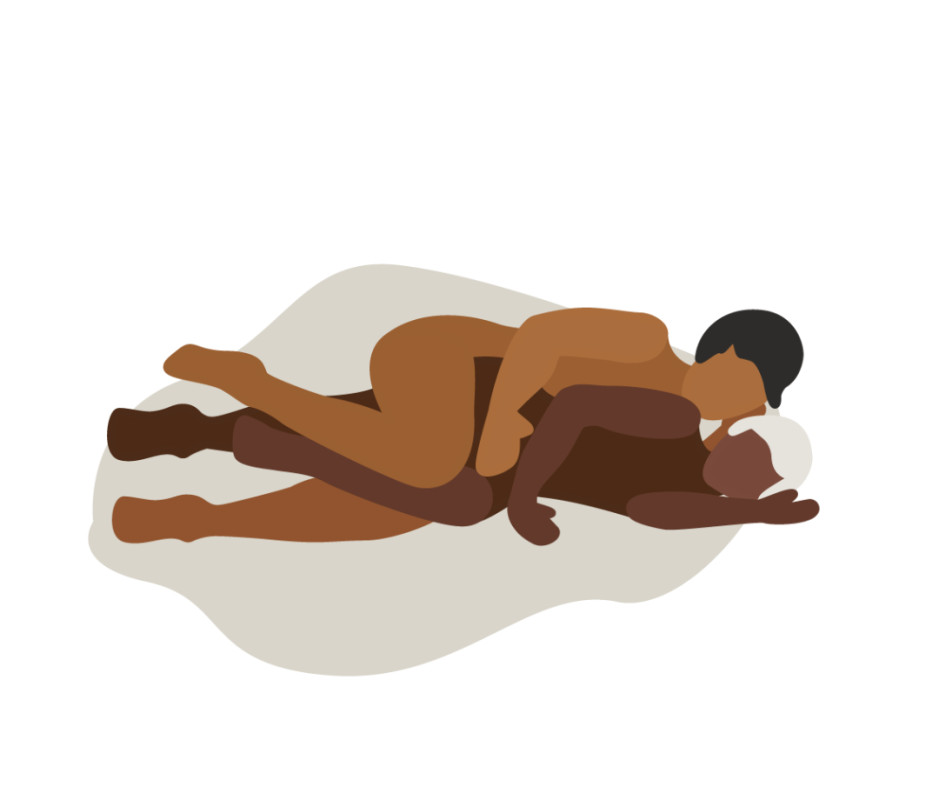
Katie Buckleitner
How to Do It
The receiving partner lies on their side with their back toward their partner, while the penetrative partner applies lube and aligns their pelvis to the receiving partner’s butt to assume the “spooning” position. The receiving partner can arch their low back and extend their bottom leg long while bending the top one closer to their chest to create more space for the giver to rest their top leg over them and enter. “Because half of the body is being restricted by the bed, it can be difficult to make adjustments once started,” explains Dr. Rossana Sida, a licensed marriage and family therapist and AASECT-certified sex therapist in Los Angeles, CA.
Why It Works
“This is the best on a lazy morning where relaxation and intimacy are key,” says Sida. It doesn’t require acrobatics, plus the receiving partner can touch their partner or themselves, either masturbating or giving attention to erogenous zones to enhance arousal.
| Pros | Cons |
|---|---|
|
Heightened intimacy between partners |
Difficult to find the right angle |
|
Low-energy position, perfect for morning sex |
Hard to get the leverage to thrust in and out |
|
Lots of skin-to-skin contact |
Pro Tip
The receiving partner can place a small sex wedge or pillow, like Foam Heart Sex Pillow, between their knees if both are tucked to maintain space and limit fatigue.
3. Missionary
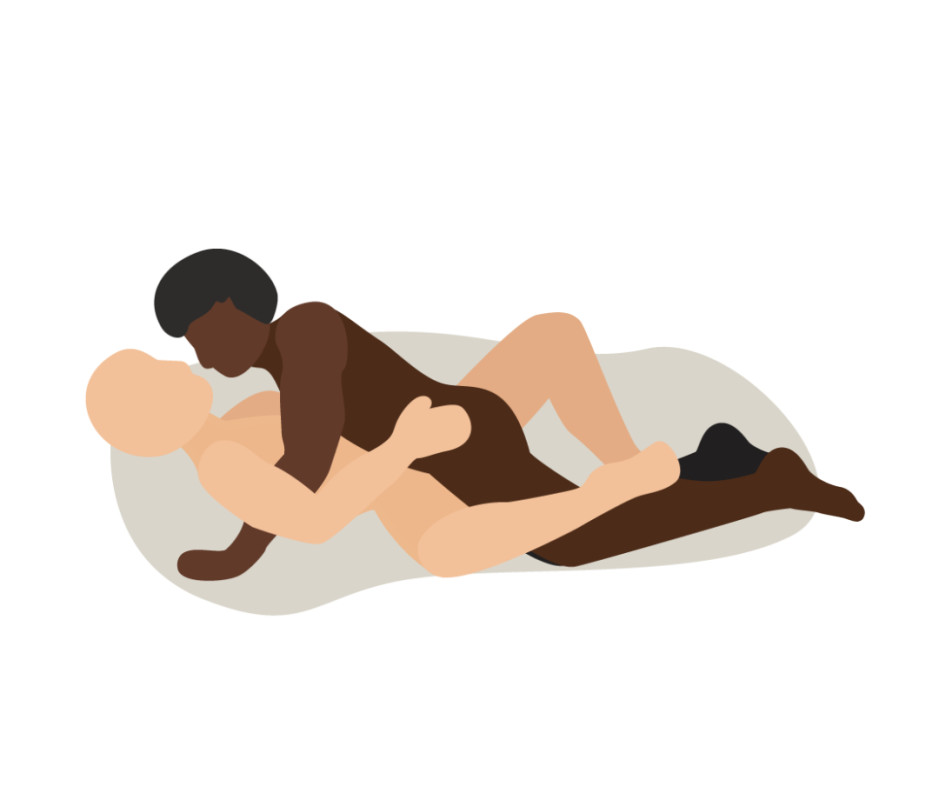
Katie Buckleitner
How to Do It
The receiving partner lies on their back with legs butterflied open, while the giver lies on top and supports their body weight with their arms. The penetrative partner enters so they’re face-to-face. To modify this, the receiving partner can place their legs over the giver’s shoulders for more direct prostate stimulation.
Why It Works
Missionary is a classic position that offers a high degree of emotional connection due to the direct eye contact, says Deerhart. You get feedback in real time and can read each other’s facial expressions.
| Pros | Cons |
|---|---|
|
Promotes a heightened sense of connection due to eye contact |
Can be overwhelming sometimes for men who would prefer to be less emotionally seen |
|
Can read facial expressions for real-time feedback |
Can be physically demanding for the penetrator who has to hold their upper body—or the receiver’s legs—up |
|
Provides direct angle for prostate stimulation |
Pro Tip
Use a sex wedge to elevate the bottom partner’s hips. We like Liberator Wedge Intimate Sex Positioning Pillow. The 27-degree angle is the ideal pitch for deeper penetration and stimulation.
4. Standing (Bodyguard)

Katie Buckleitner
How to Do It
The receiving partner stands with knees slightly bent for stability, facing away from their partner. They can stand in front of a wall and support their body weight with their hands or stand before a bed and brace their weight by kneeling one leg on it (shown). If kneeling one leg, the receiving partner can lean forward slightly and reach behind and grab their partner’s hips or thighs for greater balance. “While adequately lubricated, the penetrative partner will insert their penis, being mindful of their partner’s comfort,” says Sida. The giver should tilt their pelvis up and choose between a more sensual or vigorous rhythm of movement. Whichever feels best, both partners will need to move their hips in sync with each thrust.
Why It Works
This is an easy anal sex position to bring role play into your repertoire. Also known as “bodyguard” position due to the restraining nature of the position, you and your partner can play with domination. Moreover, the receiver can additionally masturbate while receiving anal if standing in front of a wall for balance.
| Pros | Cons |
|---|---|
|
Allows for spontaneity as standing means you can have sex in the kitchen, home office, or shower |
Both partners need to have good balance |
|
May be too physically demanding for an entire sexual experience, but it can start things off |
Pro Tip
Have the penetrative partner insert a vibrating butt plug like Lovehoney Butt Tingler 10 Function Vibrating Butt Plug. It’s great for intermediate users what with its four-inch length and flared base. The bulb houses a removable bullet vibrator that has three vibration speeds and seven patterns to find the right sensation.
5. Rusty Trombone
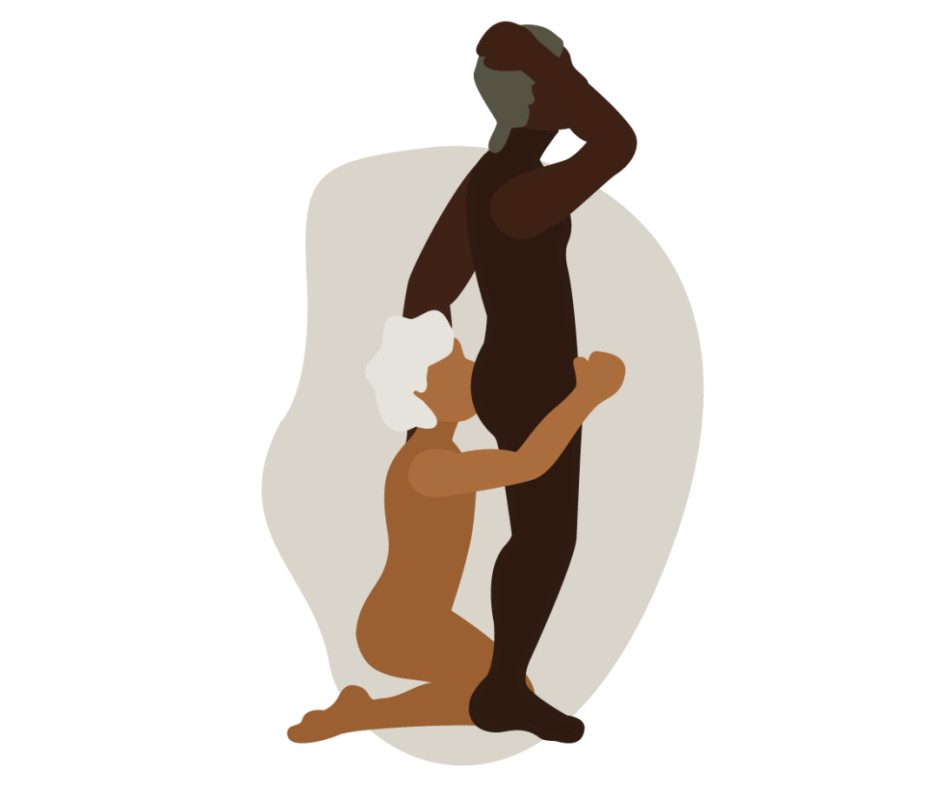
Katie Buckleitner
How to Do It
The receiving partner stands with legs slightly apart, while the giving partner kneels behind them, performing analingus (aka rimming) while simultaneously providing a hand job. The position vaguely resembles playing a trombone. For the giver, it requires plenty of coordination between the hand and mouth.
Why It Works
This is a multifaceted experience for the receiver, as it combines oral and manual stimulation for intense pleasure, says Bedbible.com sex educator Kasia Halinowska.
| Pros | Cons |
|---|---|
|
Provides dual stimulation as a rim job and hand job |
Requires flexibility and balance |
|
Difficulty to master coordination for giver |
Pro Tip
Get in the shower together beforehand and get really clean. This will put both of you at ease if you’re starting with optimal hygiene. Our favorite unscented body wash is Nécessaire Fragrance-Free The Body Wash.
6. Legs Up
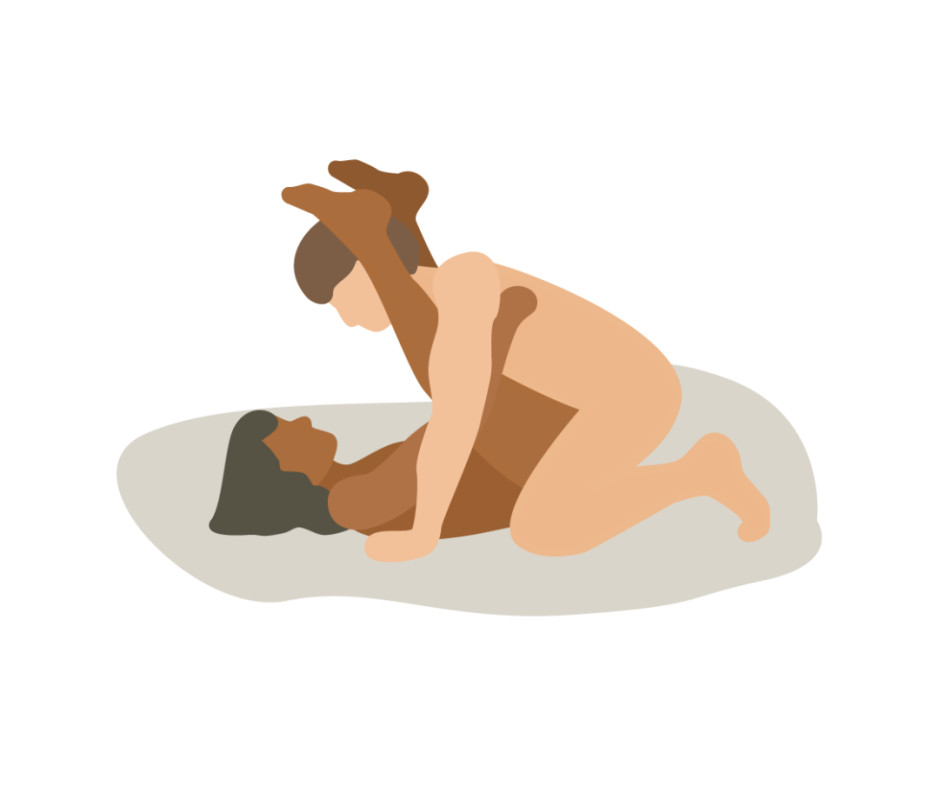
Katie Buckleitner
How to Do It
The receiving partner lies on their back with legs up so the penetrative partner can kneel, place their hands on either side of them, and slowly ease in. The receiving partner can lift their hips and rest their calves against the penetrative partner’s shoulders, which allows for deeper penetration, as well as greater support.
Why It Works
The receiving partner won’t get fatigued having to hold their legs up on their own, and this face-to-face positioning helps “maintain eye contact for intimacy,” says Halinowska.
| Pros | Cons |
|---|---|
|
Promotes deep connection with face-to-face contact |
Might not allow for very deep penetration |
Pro Tip
Try a hybrid lube that comprises water and silicone, like Hello Cake Tush Cush, for greater comfort and longevity. It won’t dry out as quickly as other lubes and helps prevent tearing.
7. Back It In
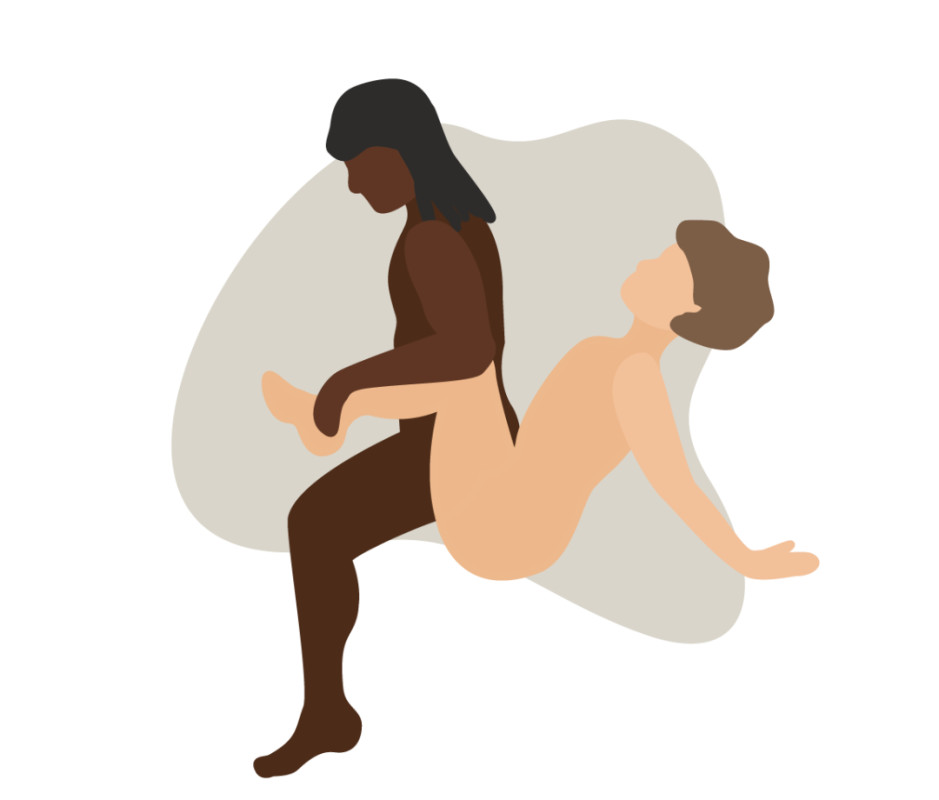
Katie Buckleitner
How to Do It
The giving partner sits in a chair with knees to chest, torso angled back in a reclined position. Use pillows to provide the proper support and get the angle right. The receiving partner backs into the position and lowers onto their partner’s penis. The receiving partner should use their legs to lower up and down.
Why It’s Great
This is a position for those chasing novelty—who want a change of pace, says Halinowska.
| Pros | Cons |
|---|---|
|
allows for control over depth of penetration |
can be a bit awkward to get into position initially |
|
difficult for giving partner to keep legs elevated without support |
|
8. Helicopter
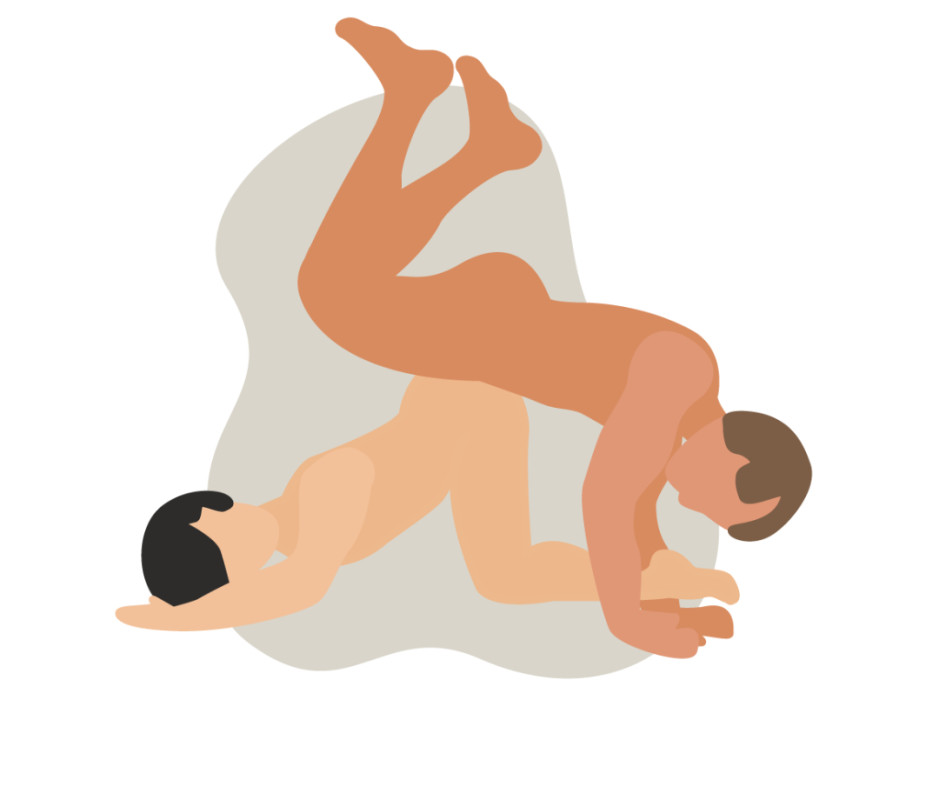
Katie Buckleitner
How to Do It
The receiving partner gets on hands and knees, then lowers down to their forearms, to start. The penetrative partner does a down dog over them, head positioned by the receiving partner’s feet, and aligns their pelvis with the receiving partner’s anus. The giver penetrates their partner as they lift their legs to create a helicopter shape. The penetrative partner will keep their pelvis on the receiving partner’s butt, using their arms to support their body (think pushup position), explains Halinowska.
Why It’s Great
You won’t get deep penetration, but due to the downward angle of the penetrative partner’s penis, it stimulates the head. Helicopter is fun and challenging, bringing a bit of spontaneity to your sex life if things have felt ho-hum
| Pros | Cons |
|---|---|
|
adds novelty to sex |
penetrating partner must have a strong upper body to maintain |
|
provides unique entry and stimulates the head of the penis |
difficult to maintain balance and find rhythm |
9. Cliff Diver
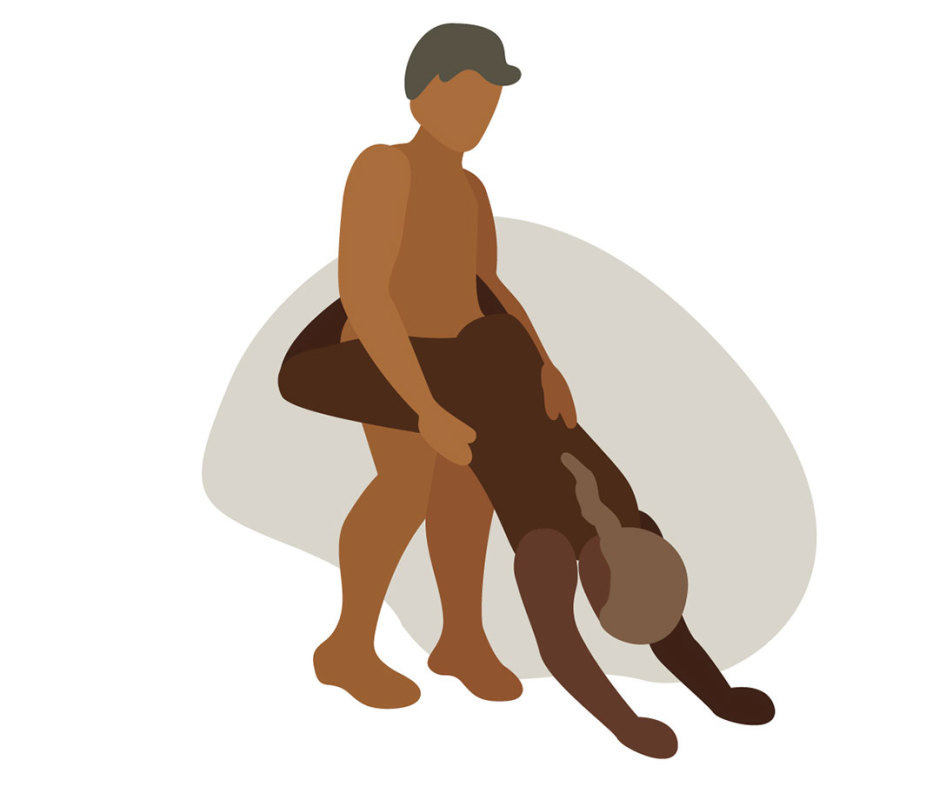
Katie Buckleitner
How It Works
The receiving partner gets on all fours while the giving partner helps lifts their legs off the ground, one at a time, wrapping them around their waist for more control and support. The penetrative partner then inserts their penis and holds onto the receiving partner’s hips.
Why It’s Great
It’s a little more advanced, but for those looking to experiment with standing sex positions, this can create a strong prostate orgasm.
| Pros | Cons |
|---|---|
|
Exciting and adventurous for couples |
Requires strength and coordination |
|
Provides intense stimulation |
Not suitable for all fitness levels |
|
Can be scaled to a chair to limit the load on the receiving partner’s arms |
10. Pirates Booty
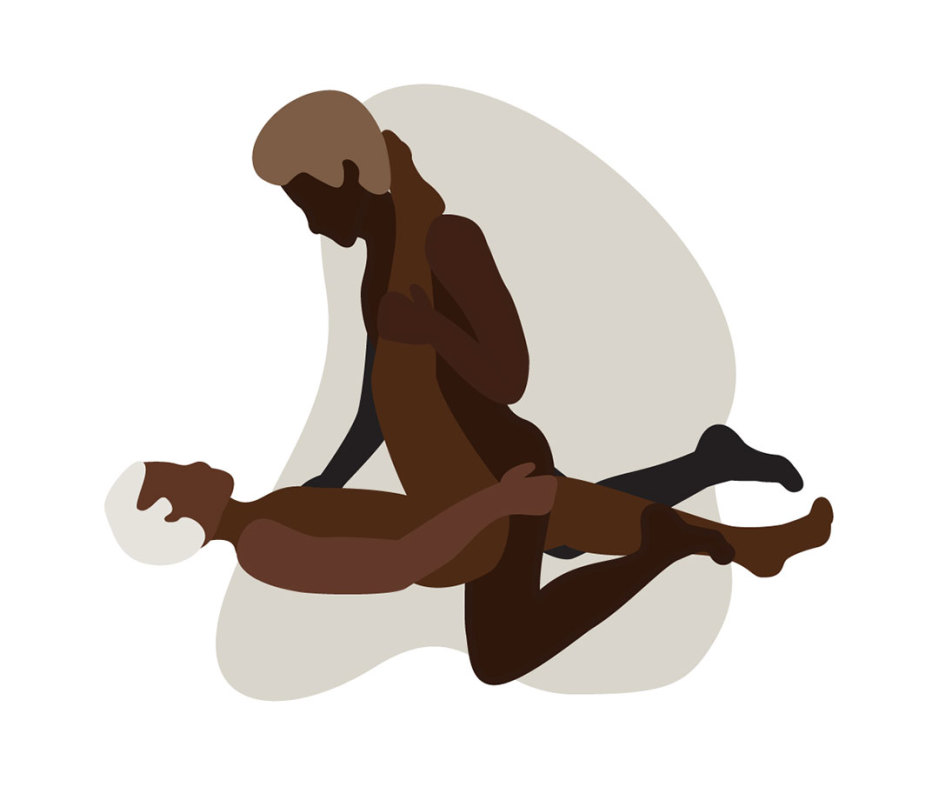
Katie Buckleitner
How to Do It
“This is a twist on missionary position that allows for deeper penetration,” prefaces Searah Deysach, sex educator and owner of Early to Bed. The receiving partner lies on their back with one leg down and the other leg in the air. The penetrative partner straddles the planted leg, slides in, then rests the receiving partner’s extended leg on their shoulder. “This allows the giver easy access and a great view,” says Deysach.
Why It Works
Pirate’s booty is for couples looking for a missionary sex position variation that’s outside the norm. It allows for deep penetration.
| Pros | Cons |
|---|---|
|
Both parties can kiss and cuddle while in this position |
Receiver needs to have good hip flexibility |
|
Receiver can stimulate his penis easily (and the giver can help if they don’t need both arms to balance) |
Lifting just one leg can cause the pelvis to tilt, which might make the penetrator hit the side of the pelvic bone |
|
Communication is easier when looking at each other |
Pro Tip
Lifting just one leg can cause the pelvis to tilt, which might make the top hit the side of the pelvic bone. To avoid this, you might have to lift both legs to keep the pelvis level.
11. London Bridge
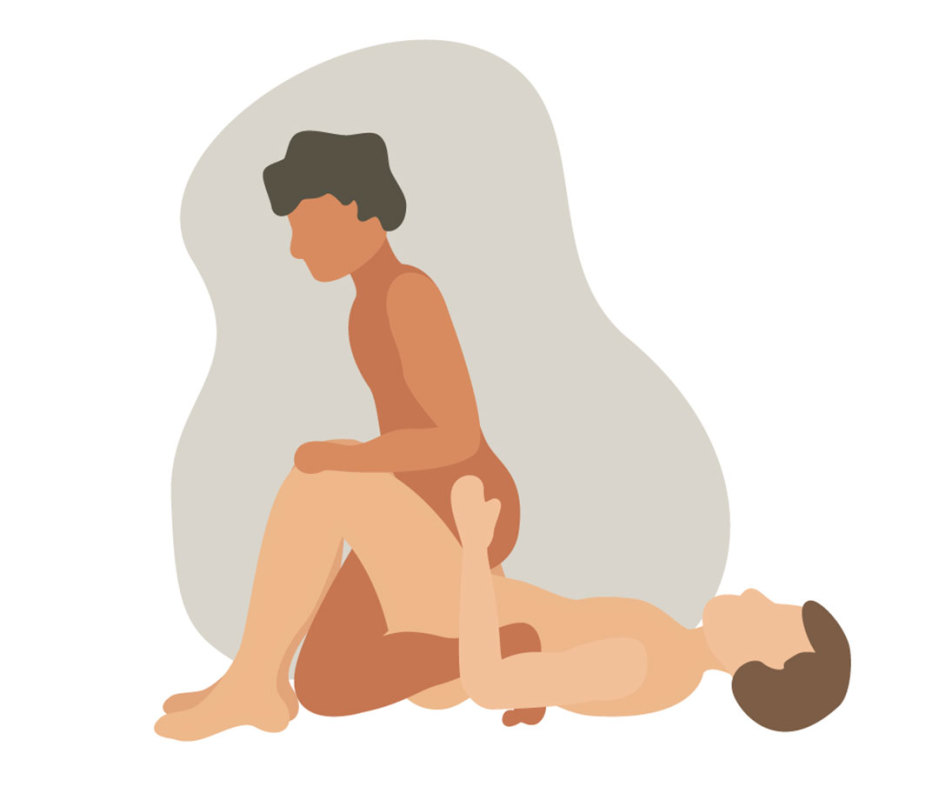
Katie Buckleitner
How to Do It
The penetrative partner lies on their back, feet flat, knees bent. The receiving partner backs on top of the penetrative partner, between their legs, easing onto their partner’s penis while facing away. “It’s a reverse insertion position,” says sex educator, Goody Howard. “The rider can grind down, lift their hips, dance, squeeze their sphincter muscles for mutual pleasure, and put their hands on their partner’s knees for stability and leverage,” says Howard. “For even more leverage, the rider can “lower the bridge” even further and put their elbows on the bed (or floor).”
Why It Works
This position is actually the great equalizer for couples who may have larger height and weight differences. It also perfectly aligns the penis and anus and is less taxing than other non-traditional positions.
| Pros | Cons |
|---|---|
|
Low impact on the knees and back |
Rider needs to be careful when leaning down. It’s important to finesse and smoothly transition from upright to leaning on elbows |
|
Great for genital alignment, so big height differences don’t matter as much |
|
|
Good for plus-size couples |
|
|
Increases sensitivity for the person being ridden |
Pro Tip
To ensure you don’t have to stop before the climax to add more lube, try Lelo F1L. The long-lasting, water-based lubricant is hypoallergenic and unscented.
12. 69

Katie Buckleitner
How to Do It
Both partners lie in opposite directions: one partner’s head on the other’s cock and vice versa, sucking each other at the same time. “This position is great for Sides, men who love sex with men but don’t enjoy anal sex,” says Deerhart. “The 69 sex position makes it possible for each to relax into mutual receptivity since both are receiving oral at the same time.”
Why It Works
“The magic of 69 is it releases each man from any pre-existing, prescribed roles and allows each to stay focused on the pleasure of giving and receiving without a fixed context,” adds Deerhart. Plus, the partner on bottom can give a rim job or a blow job.
| Pros | Cons |
|---|---|
|
Heightens the odds of mutual orgasm |
Some partners can get overwhelmed and lose the ability to stay focused on their own pleasure |
|
No set “roles” for partners |
Related: The Best Nipple Clamps of 2024 for Maximum Pleasure
13. Lotus
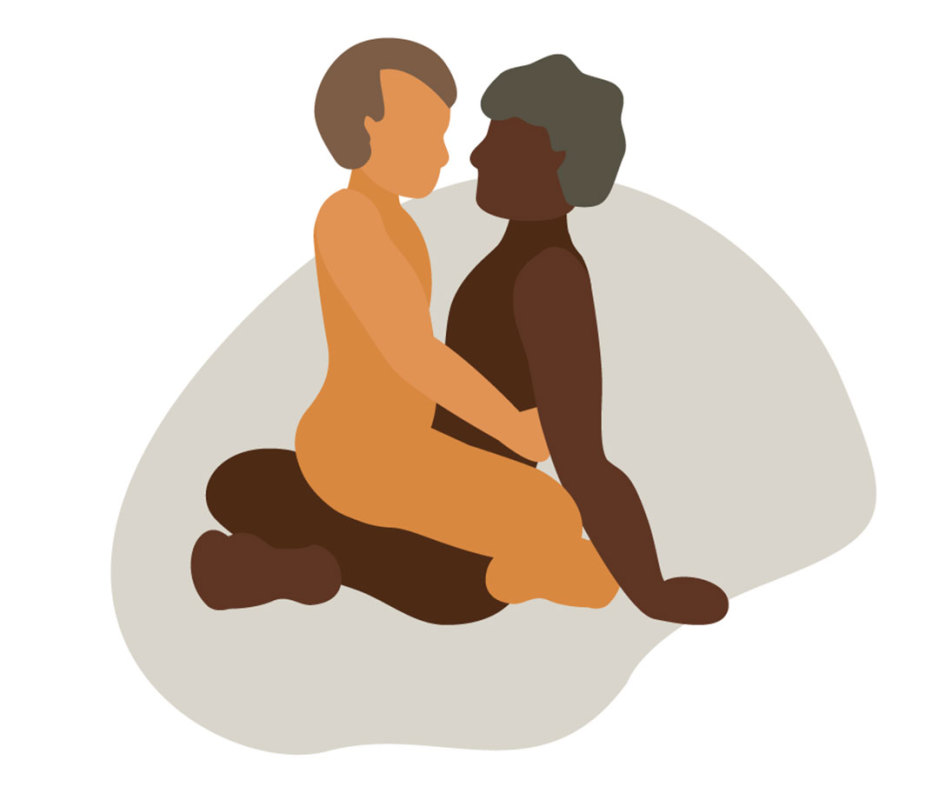
Katie Buckleitner
How to Do It
Lotus is a tantric sex position. To get into it, the bottom (penetrative) partner sits cross-legged, torso upright, then the receiving partner straddles them so they’re face-to-face. The top partner can also cross their ankles or have feet touch, says Halinowska, and both partners can wrap their arms around each other. This is more of a rocking position, with the top partner controlling the speed and rhythm. To help counterbalance, the bottom partner can lean their hands back for greater support and leverage.
Why It Works
Lotus is an incredibly intimate position, as it encourages and maintains eye contact between partners.
| Pros | Cons |
|---|---|
|
Promotes full-body, sensual contact, and deep connection |
Might not be ideal for extended periods due to the seated position’s strain on hip flexors |
|
Hands are free to roam |
14. Squatter’s Rights
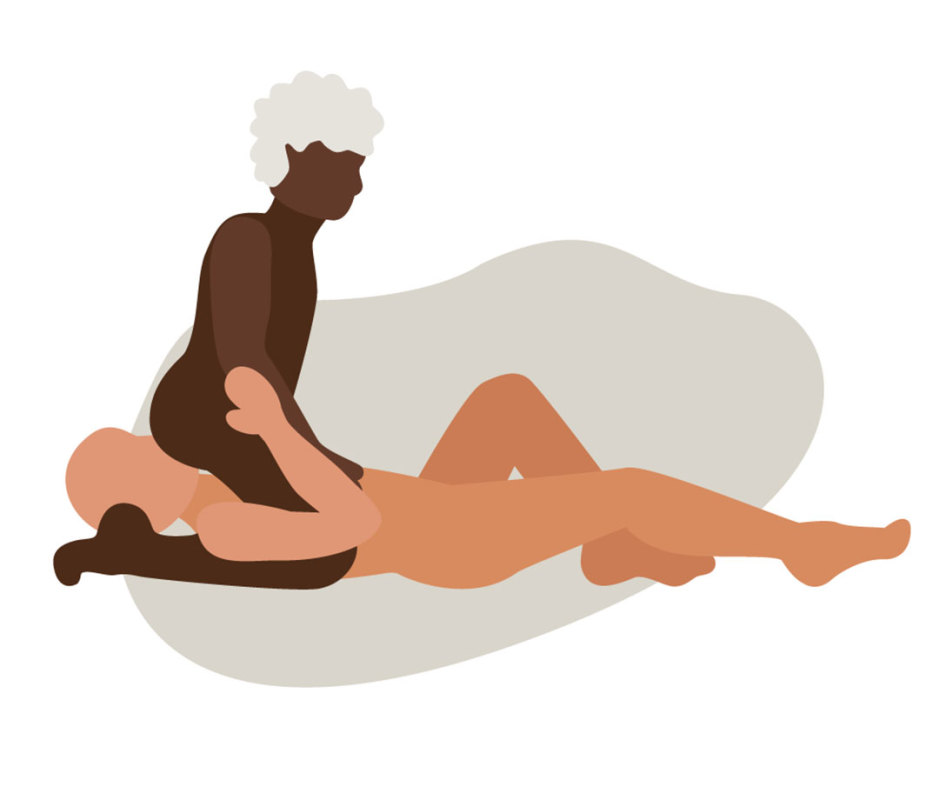
Katie Buckleitner
How to Do It
This reverse face sitting position flips the script and puts the emphasis on analingus. The receiving partner hovers their body over the giver’s mouth, taking care not to put too much body weight on their face. The receiver can use their legs to brace their weight and place their hands on their partner’s chest for balance, explains Halinowska.
Why It Works
This is a playful take on oral sex that also hedges into dominance and submission, as the receiving partner has the control.
| Pros | Cons |
|---|---|
|
Concentrated oral stimulation for receiver |
Might get uncomfortable for the giver’s neck |
Pro Tip
Use a wedge like Liberator Flip Ramp under the giver’s head for greater neck support.
15. Cowboy
Katie Buckleitner 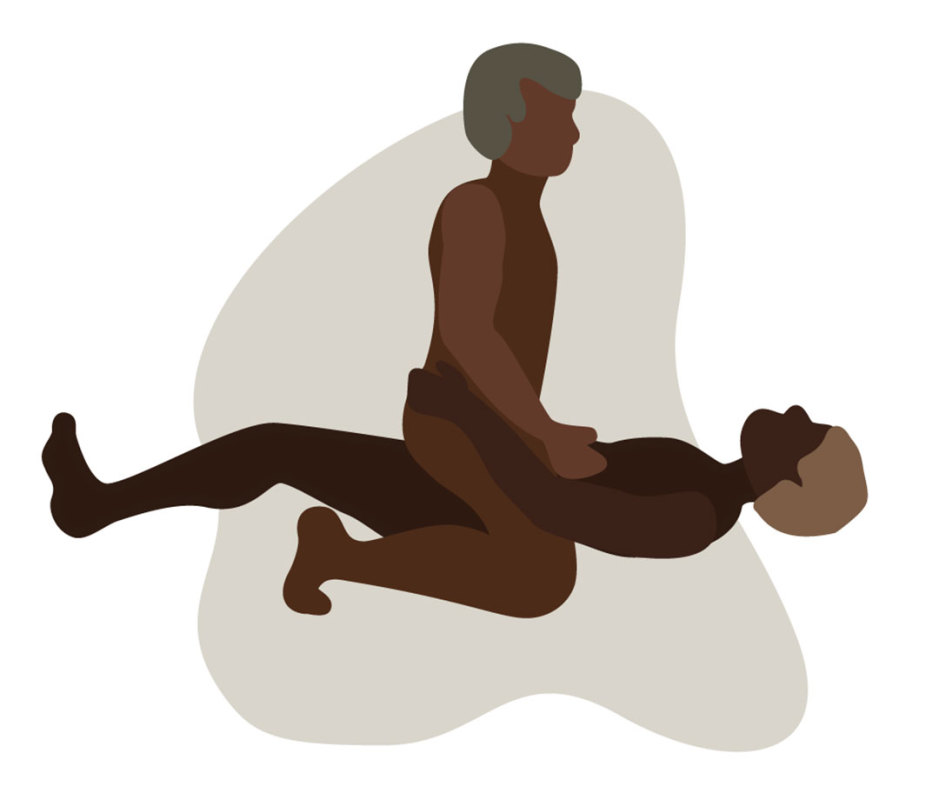
How to Do It
The receiver lies down on their back, and the receiver, facing him, eases down on the penetrator’s penis and bucks at the rate that feels good to him. “This position is great for receivers who want more control over the experience,” advises Deerhart.
Why It Works
“The receiver gets to decide how deep, fast, and intense the thrusting goes,” says Deerhart. “So they’re more likely to open up and freely enjoy being penetrated.”
| Pros | Cons |
|---|---|
|
The receiver can decide duration and intensity. |
This position can sometimes cause a penetrator to lose their hard-on since the flow of gravity naturally pulls blood downward in the erection. |
|
Some guys who penetrate in this position may feel too restricted, since the receiver is sitting on top of their body and taking charge. |
Meet the Experts
- Finn Deerhart, AASECT-certified sexuality counselor
- Dr. Rossana Sida, licensed marriage and family therapist and AASECT-certified sex therapist in Los Angeles, CA
- Kasia Halinowska, Bedbible.com sex educator
- Searah Deysach, sex educator and owner of Early to Bed
- Goody Howard, sex educator
Related: 10 Best Sex Swings of 2024: Why You Should Make a Push for One
-

 African History5 years ago
African History5 years agoA Closer Look: Afro-Mexicans 🇲🇽
-

 African History8 months ago
African History8 months agoBlack History Facts I had to Learn on My Own pt.6 📜
-

 African History5 years ago
African History5 years agoA Closer Look: Afro-Mexicans 🇲🇽
-

 African History1 year ago
African History1 year agoMajor African Tribes taken away during the Atlantic Slave Trade🌍 #slavetrade #africanamericanhistory
-

 African History1 year ago
African History1 year agoCameroon 🇨🇲 World Cup History (1962-2022) #football #realmadrid #shorts
-

 African History1 year ago
African History1 year agoWhat did Columbus Find in 1493? 🤯🔥🔥 #history #civilization #mesoamerica #africa #kemet
-

 African History7 months ago
African History7 months agoBlack History Inventors: Mary Kenner 🩸
-

 African History1 year ago
African History1 year agoOrigin Of ‘Cameroon’ 🇨🇲😳#africa





































